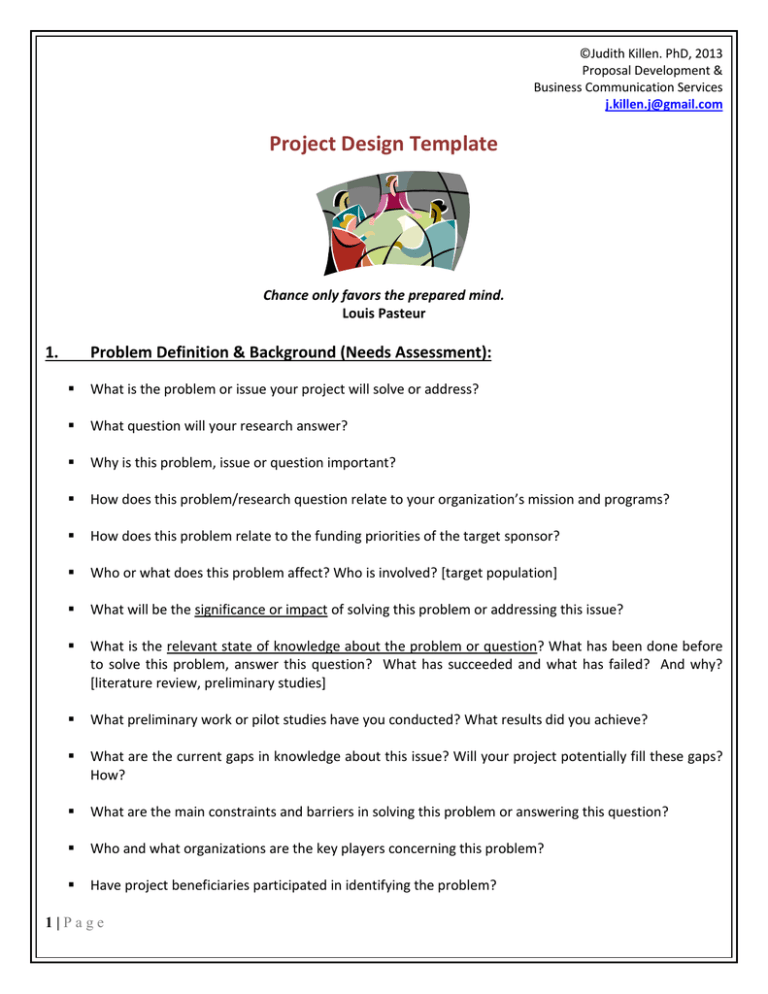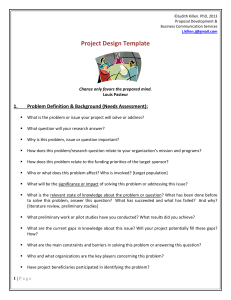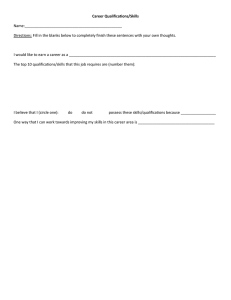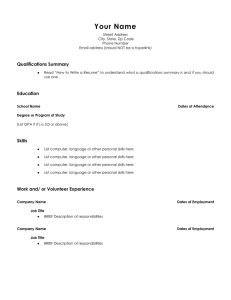Project Design Template 1. Problem Definition & Background (Needs Assessment):
advertisement

©Judith Killen. PhD, 2013 Proposal Development & Business Communication Services j.killen.j@gmail.com Project Design Template Chance only favors the prepared mind. Louis Pasteur 1. Problem Definition & Background (Needs Assessment): What is the problem or issue your project will solve or address? What question will your research answer? Why is this problem, issue or question important? How does this problem/research question relate to your organization’s mission and programs? How does this problem relate to the funding priorities of the target sponsor? Who or what does this problem affect? Who is involved? [target population] What will be the significance or impact of solving this problem or addressing this issue? What is the relevant state of knowledge about the problem or question? What has been done before to solve this problem, answer this question? What has succeeded and what has failed? And why? [literature review, preliminary studies] What preliminary work or pilot studies have you conducted? What results did you achieve? What are the current gaps in knowledge about this issue? Will your project potentially fill these gaps? How? What are the main constraints and barriers in solving this problem or answering this question? Who and what organizations are the key players concerning this problem? Have project beneficiaries participated in identifying the problem? 1|Page 2. Proposed Solution—Project Goal & Objectives: What is the ultimate purpose of your project? (Goal) What will change or happen as a result of the project? (Outcome Objectives) What is your theoretical framework or approach? What other approaches could be taken to this problem or question, and what are the comparative and compelling advantages of your approach? 3. Plan of Work What activities will be undertaken to achieve the goal and objectives? What specific activities will be conducted to achieve each objective? Each activity should clearly relate to the achievement of one or more of the stated objectives. What are the expected outputs and outcomes of each activity? How will these activities generate the desired outcomes? Develop a project implementation time line? When will activities occur? When will outputs and outcomes be generated? Break out your project timeline by quarters or months depending on funder requirements. Every activity should be on the implementation timeline. What methods or means will be used to carry out your activities? What is the rational for using these? How are proposed activities, methods, and means based on lessons learned? Why are proposed activities the best waymost effective, cost efficient, most equitableto solve this problem or address this issue? What other solutions were considered? Why were these rejected? 4. Project Beneficiaries [Target Population] Who will benefit from the project, and how will they benefit? State demographics and numbers. Why is this project of more benefit now than other projects that could be funded? How did and how will project beneficiaries or target groups participate in the project? Does the project address a problem as identified, defined, and articulated by the groups the project is supposed to benefit? Did the project’s beneficiaries help identify the problem, design the project and the solution to the problem? 2|Page How will project beneficiaries help implement and manage the project? Has the project been designed so that all involved groups have equitable and appropriate access to project resources? How will implementing this project change and improve (build capacity within) your organization? 5. Project Management How will the project be managed and/or administered within your organization? Who is the project manager/PI and what are her/his qualifications for the role? How will you coordinate staff, partners, and subcontractors? How will you supervise field staff who may report to someone other than the project manager/PI? How will money flow? Who will do procurement? What bid process will be used and why? 6. Project Personnel (partners & subcontractors) Who are the key people involved in the project? Who will carry out each activity? What existing staff will assist with the project? (Don’t forget field staff!) Will you need to hire project-specific staff for the life of the project? What is each person’s role and responsibility on and qualifications for the project? What will they do? What skills do they need to have? What organizations will you partner/coordinate with? What do you expect each of your partners to do/contribute? List official name of all partners and historic and current relationship in the context of this project. Will you need to subcontract significant portions of the project? If so, describe what will need to be subcontracted, and the skills and experience needed. Include a project organizational chart. Develop resumes/biosketches for key staff tailored to their roles on this project and in required sponsor formats. 3|Page 7. Partner Organizations What is each partner organization’s role and responsibility on and qualifications for the project? Why have you chosen these organizations to be involved in the project? What institutional capacity and expertise do they bring to the project? How will they increase the likelihood that the project meets its objectives and has impact? What are their key institutional qualifications and experiences for this project? Develop Memoranda of Agreement and Letters of Commitment. 8. Project Monitoring & Evaluation What are the key indicators of project progress, impact, and success? How will these be tracked and measured? Is a baseline survey necessary? What are potential barriers to success and when may they occur? What methods and techniques will be used for overcoming potential barriers to success? How will information from project monitoring and evaluation be used to review activities and revise methods and processes? What is the evaluation schedule? What project data will you request or keep? For how long (e.g., through payback period)? What will you do with the data? 9. Sustainability If appropriate, how will project activities or impacts continue when outside funding ends? How is sustainability built into the project design? What techniques will be used in project implementation to ensure sustainability of impacts and activities? 10. Information Dissemination What are the potential lessons learned from this project? Who are the potential audiences for results and lessons learned? Who needs or would be interested in the information the project generates? 4|Page How will these “lessons learned” be disseminated during and after the project? How do dissemination modes and methods meet the needs of the various audiences? 11. Budget & Funding Plan Each activity in your plan of work will have a corresponding cost (whether cash or in-kind match, part of your federal grant request or from another source). Identify other organizations that may/will make a financial contribution to this project (in kind or cash). What will they provide? For what purpose? 5|Page





